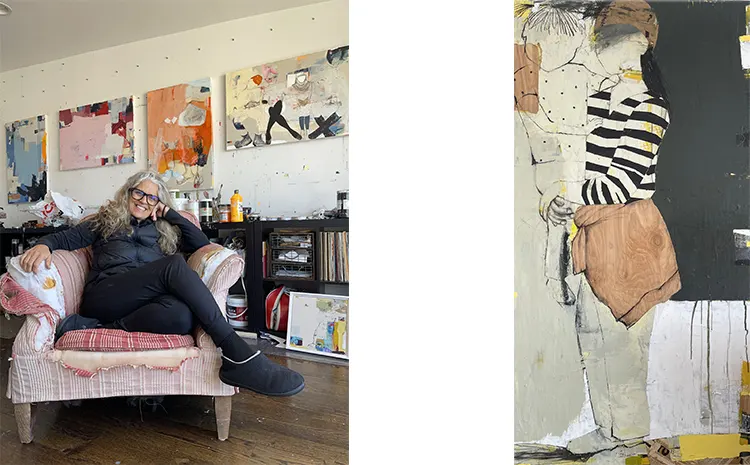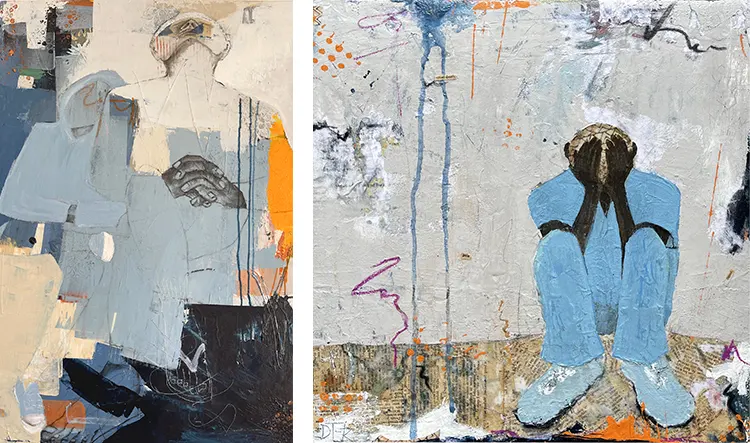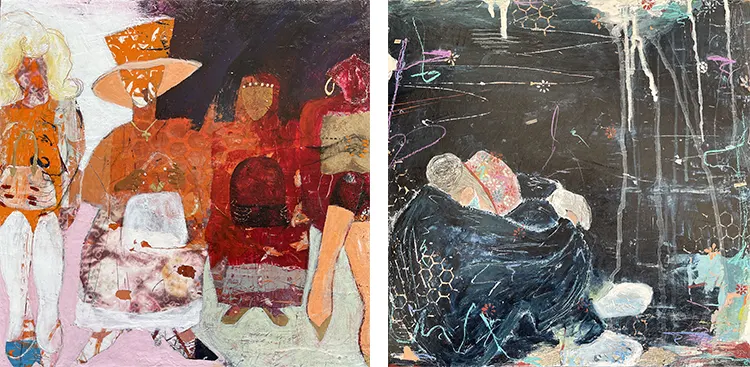“I picked up a paintbrush, and started to paint my grief and anger, and since then I’ve not stopped.”
Capturing Joy: The Artistic Retreat in Rural Pennsylvania
Debbie Taylor-Kerman, a distinguished artist of Scottish origin, presently finds her home nestled amidst the vibrant atmosphere of Harlem, NYC. Glasgow, her birthplace, steeped in the traditions of a working-class neighborhood, shaped her early experiences and views of life. This environment, accentuated by her parents’ own impoverished upbringing in the same city, instilled within her a deep-seated empathy for the marginalized, nurturing an enduring need to advocate for equality and inclusivity through her unique artistic voice.
Despite her profound desire to paint, Taylor-Kerman initially held reservations about her place within the world of art, considering it largely inaccessible to those of her working-class background. Coupled with her practical need for financial security, she initially chose to carve out a niche for herself within the commercial art realm. However, her creative impulse continued to simmer beneath the surface, constantly yearning for an opportunity to express her distinct narrative.
This internal conflict found resolution in 2019 when she partook in a transformative class with renowned artist Nicholas Wilton. The subsequent year marked a poignant period of introspection for Taylor-Kerman, as personal loss interwove with societal turbulence. The tragic demise of her father to Covid-19 in Scotland, followed by the heart-wrenching incident of George Floyd’s murder, acted as a catalyst for her evolution as an artist. Harnessing her grief and outrage, she wielded her paintbrush as an instrument of catharsis, unabatingly exploring her emotional landscape through the medium of paint.
August 2020 marked a pivotal moment in her career as she began sharing her expressive artwork via Instagram, capturing the admiration of a diverse international audience. The overwhelming positive reception led to her works being acquired by art enthusiasts worldwide. This significant turning point allowed Taylor-Kerman to relinquish her commercial design ventures, devoting herself entirely to her true passion – painting her truth, her story, and her voice. From that moment forward, she has been unflinchingly dedicated to her pursuit of authentic artistic expression.

Exploring the Intricate Layers: Debbie Taylor-Kerman’s Artistic Style
During the global pandemic, Debbie Taylor-Kerman faced the emotional turmoil of her youngest son, a high school senior at the time, grappling with deep depression. In an attempt to counter this despair, Taylor-Kerman orchestrated a ten-day retreat to a serene home in rural Pennsylvania, transforming it into a sanctuary for her son and his closest friends. This excursion, a vivid deviation from their New York City lockdown routine, was a veritable breath of fresh air. The period was immortalized through a portrait Taylor-Kerman painted of the boys, a piece that continues to evoke strong emotions of joy, as she believes she successfully encapsulated each of their distinct personalities using minimalistic elements.
Taylor-Kerman’s artistic style is best described as contemporary mixed media abstract figurative. Her preferred mediums include acrylic and mixed media, which she employs to build layers of intricate depth, creating an intriguing juxtaposition of elements and a palpable historical undertone. Through the use of various tools, she intentionally relinquishes control, allowing the artwork to evolve organically. Her pieces strike a careful balance between figurative and abstract art, a constant interplay of revealing and concealing, guided by the core artistic inquiry: What needs articulation, and what merits strategic silence?
Upon her relocation to Harlem in 2006, Taylor-Kerman found herself drawing parallels between her white working-class upbringing and the culture of her new neighborhood. Yet, she remained conscious of the privilege her skin color afforded her, an aspect she continually strives to comprehend fully. This perspective influences her art, fueling her dedication to championing cultural diversity.
Taylor-Kerman’s work serves as a testament to her belief in the paramount importance of cultural diversity. The artist finds herself consistently drawn to the narratives of the underdog, deeply moved by those often perceived as “social outcasts” who maintain their individualistic paths with courage. Her passion for women’s issues, her unwavering stand against racism and inequality, and her commitment to celebrating diversity and inclusion are all themes consistently echoed throughout her work.

Fostering Cultural Diversity: Debbie Taylor-Kerman’s Artistic Vision
Debbie Taylor-Kerman’s artistic preferences gravitate towards acrylic paint, owing to its quick-drying nature. Her artistic process often involves juggling multiple pieces at once, shifting focus fluidly among them. Her love for texture and layers becomes evident when she employs a sander on the freshly dried layers, creating depth and nuance in her work. Taylor-Kerman’s adoration for charcoal sketches adds another layer to her work, often mixing charcoal with her acrylics and collage materials. Although the vibrancy of oil paints is widely appreciated, she eschews them due to their protracted drying times and overwhelming scent, which doesn’t align with her working style.
As for the influences on her style, the artist’s list is headed by her teacher, Nicholas Wilton. Taylor-Kerman’s penchant for faceless figures was greatly inspired by Mark English’s similar artistic explorations. Joan Eardley also plays a pivotal role in shaping her artistic perspective. Among contemporary artists, Khari Turner and Jennifer Packer are two whose work deeply moves her.
A profound emotional connection exists between Taylor-Kerman and Khari Turner’s painting “Breathing Water To Air”, which moved her to tears. Turner’s paintings resonate deeply, particularly due to the socio-cultural context they embody. Systemic racism, coupled with the underfunding of neighborhoods and schools predominantly populated by African Americans, has resulted in many of them not being taught how to swim. A tragic incident in 2020 brought this reality closer to home for Taylor-Kerman when a young family friend, who had grown up in Harlem and been a college athlete, tragically drowned because he couldn’t swim. Turner’s paintings of young black children swimming evoke a surge of emotions within her, making them profoundly meaningful and evocative.

Tools and Techniques: Debbie Taylor-Kerman’s Artistic Arsenal
Debbie Taylor-Kerman possesses an eclectic assortment of tools, encompassing not only those typically associated with traditional artistry, but also items sourced from the domains of sculpture, carpentry, and even the culinary arts. This diverse collection enables her to create a unique palette of marks and textures that establish an abstract foundation for her works, a crucial step before the introduction of figures.
Taylor-Kerman acknowledges that in the contemporary world, one of the greatest challenges lies in navigating the constant call of digital distractions, particularly those stemming from social media. As a remedy to this, she consciously designates periods to disconnect from the electronic world entirely, thus ensuring her artistic focus remains undiluted.
Despite operating in a relatively compact studio space, she demonstrates an ambition to push the boundaries of her artistic scope. Her largest creations to date measure 36×36 inches, but she is presently preparing to embark on a pair of works that will considerably exceed these dimensions, at 48×60 inches each. While she harbors aspirations of tackling even more imposing scales, Taylor-Kerman adopts a measured approach, expanding her artistic canvas one step at a time.






